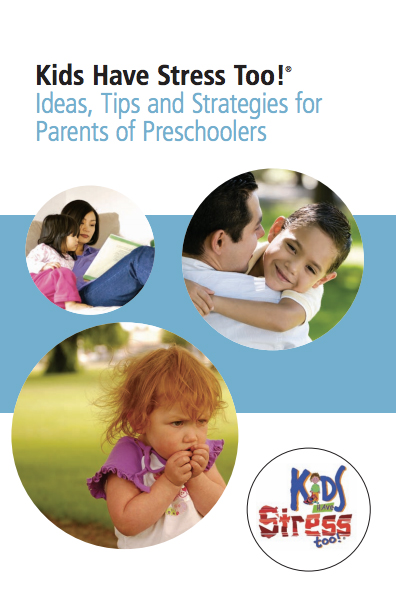Kids Have Stress Too!
 The Psychology Foundation’s booklet of Ideas, Tips and Strategies for Parents of Preschoolers, introduces the key concepts of the Kids Have Stress Too! program designed to help parents, caregivers and educators become more aware of children’s stress, and to help children cope with and develop effective ways of dealing with stress.
The booklet starts with an explanation of what stress is, looking at everyday stress, long-term or chronic stress, and the distinction between stress and anxiety. “Stress in children is usually a response to one or more external events…. Anxiety, on the other hand, is when kids become unreasonably fearful of situations which objectively aren’t dangerous, or as dangerous as they imagine them to be.”
The Psychology Foundation’s booklet of Ideas, Tips and Strategies for Parents of Preschoolers, introduces the key concepts of the Kids Have Stress Too! program designed to help parents, caregivers and educators become more aware of children’s stress, and to help children cope with and develop effective ways of dealing with stress.
The booklet starts with an explanation of what stress is, looking at everyday stress, long-term or chronic stress, and the distinction between stress and anxiety. “Stress in children is usually a response to one or more external events…. Anxiety, on the other hand, is when kids become unreasonably fearful of situations which objectively aren’t dangerous, or as dangerous as they imagine them to be.”
The booklet makes a recommendation to seek professional help if:
- Anxiety is significantly interfering in your child’s life, stopping them from doing the things that are important.
- Your child is constantly seeking abnormal amounts of reassurance.
- Your child is showing symptoms of stress and is clearly not coping well.
- As a parent, you would like to discuss parenting strategies and ways of increasing your child’s resilience.
Information is given on:
- Helping children with ‘normal’ stress, through connection, home environment, and comfort.
- Identifying the signs that a preschooler may be overstressed.
- Dealing with stress: e.g. “Be sure to support children when they seem stressed. Tell them when you notice that they seem upset. Ask them how their bodies feel (tummy, tense muscles, etc.). Explain to them that there is a connection between the way our bodies feel and emotions such as worry, sadness and anger.”
- Stress management in good times: e.g. ”Model effective stress-management strategies. When you’re feeling rushed or stressed, stop yourself and say, ‘Wow, I’m feeling stressed. I’m going to take a few deep breaths to help me calm down.’ If children see parents using stress-reducing tools in tense moments, they will learn by example”
- Some ways of avoiding stress.
- Talking about feelings: “But don’t forget that it takes a long time for children to develop emotional control. Preschoolers can’t always talk about their emotions, or even identify them, so talking about feelings is not always a quick fix for preschool stress. Keep the conversations short, comfort your child and then, when she is ready, help her to get her mind off being upset with a new activity.”
The booklet introduces one of the techniques from the Kids Have Stress Too! program, called Stop, Look and Listen! , designed to help parents tune in to their children’s stress:
- STOP
- Set the climate
- Choose the moment
- Find ‘little’ opportunities to connect.
- LOOK
- Once a day, check your child’s face and body.
- Pay close attention (to facial expressions, mood, body language and activity level).
- LISTEN
- Give full attention.
- Listen without speaking: “It can take a preschooler a long time to put the words together, particularly when he is trying to express something difficult, confusing or upsetting. Don’t finish his sentences, even if you think you know what he is trying to say. Give him time to put it into his own words.”
- JUST BE THERE
- Sometimes children don’t feel like talking about what’s bothering them. “Even when children don’t feel like talking, they often don’t want parents to leave them alone. Sometimes we can help children feel better just by keeping them company. Whether they need to talk or just be in the same room with you – make yourself available.”
- Do something fun together.
- Give children time and space to unwind. “Sometimes children need time on their own with quiet activities such as blocks, play dough or imaginative play.”
There are tips for reducing child care stress, including:
- Working with your childcare provider.
- Dealing with changes in behaviour or routine.
- Providing memories of home with a security object or mementos.
- Finding opportunities to spend time with your child by occasionally assisting at the child care
- Maintaining a positive and consistent approach to discipline at home and child care
The booklet finishes with ideas on how to handle transition times with young children and allow for differences in personality type and level of sensitivity to stimuli.
